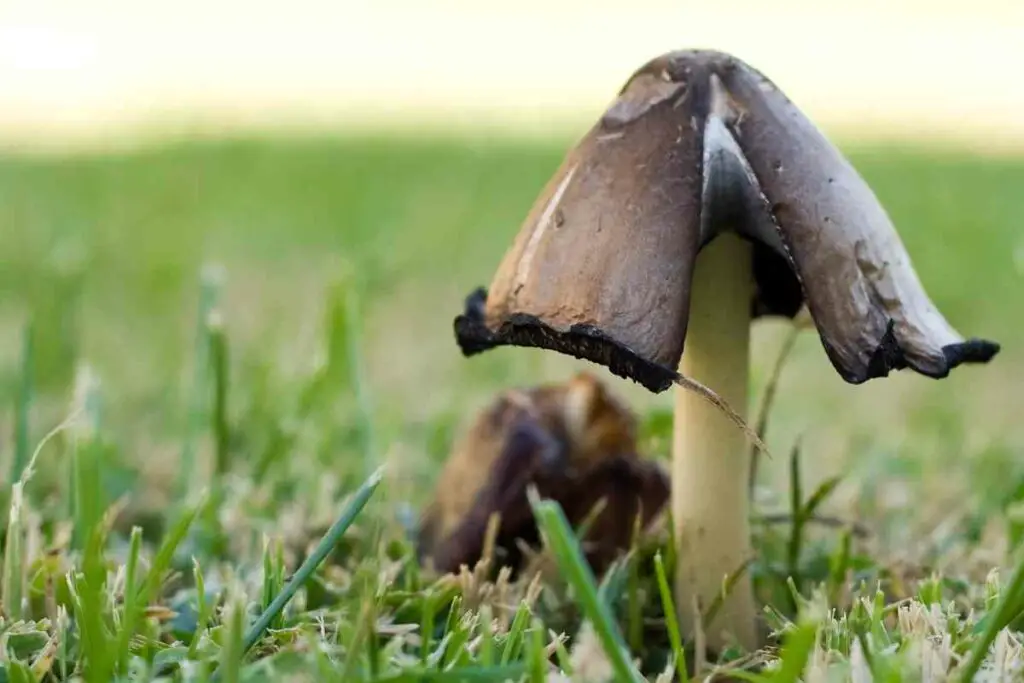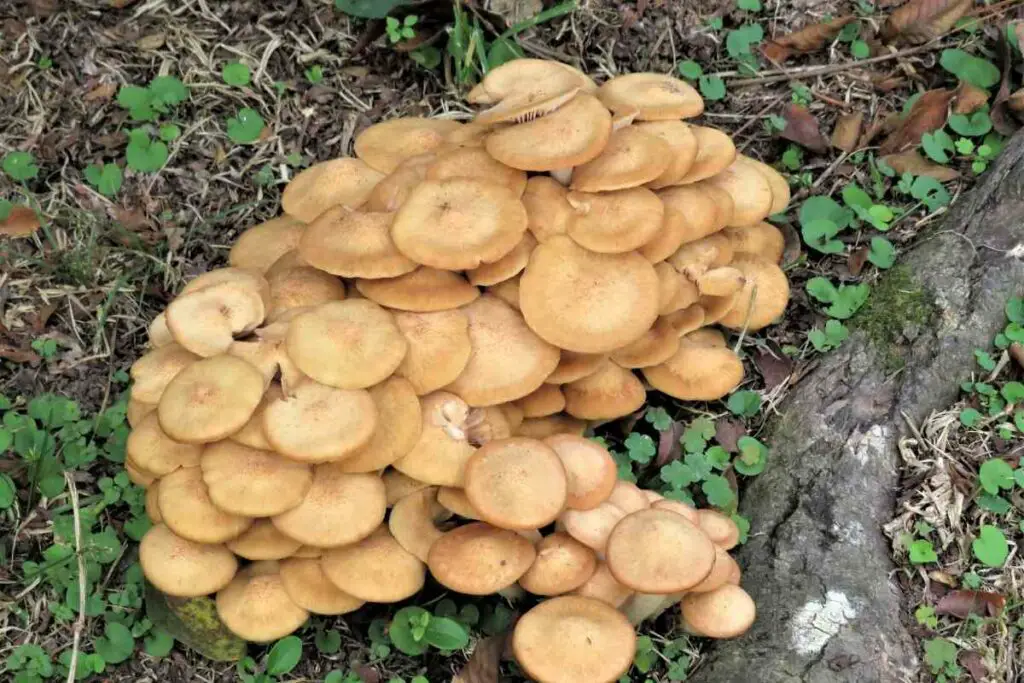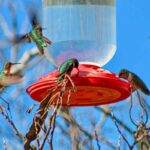Although mushrooms don’t negatively impact the health of your yard, they can affect its aesthetic beauty and may be poisonous to pets and people.
The best method to get rid of backyard mushrooms is simply changing the conditions which stimulate growth, such as moisture, shady areas, and many organic materials in the yard.
When mushrooms first appear, control the spread of spores to the rest of the backyard. Pluck the mushrooms by hand or mow, then add nitrogen, vinegar, or dish soap to the growing spots to prevent further growth.
Moreover, keep mushrooms from frequently appearing by eliminating excessive organic matter from the backyard to starve them to death.
Doing this will also improve aeration, soil drainage, soil compaction, and watering the yard less.
Also, remove objects that create shade to increase sunlight; extra sunshine helps keep mushrooms in check.

Table of Contents
9 Ways To Get Rid of Backyard Mushrooms
We’ve come up with a few ways to get rid of backyard mushrooms without harming your garden. Let’s see which works for you.
1. Clean the Backyard
One of the best strategies to eradicate mushrooms from yard areas is to keep the backyard clean.
Mushroom consumes organic matter from dead tree roots, wood, logs, clippings, mulch, leaves, old tree stumps, animal waste, etc.
Therefore removing these food sources from your yard will help keep the mushroom population under control or disappear altogether.
Since you can’t remove all organic matter in your yard, you can begin by raking up leaves, twigs, grass clippings, and any other waste products that occur in the backyard as soon as they appear.
Clean up mulch in your yard since it retains moisture, promoting mushroom growth. If your garden has a heavy covering of thatch, dethatch your lawn in places where you notice mushrooms regularly.
Mushrooms may be feeding on submerged organic materials in the soil surface. In such cases, dig up the materials to stop the constant appearance.
It is recommended that you poke the soil beneath the affected area, about 1 to 1 ½ feet deep and around 2 feet away from the mushroom bunch.
2. Moisture Control
Excess moisture attracts mushrooms into a yard. Since they need moisture to develop, eliminating the water on the yard stops their growth.
First, improve airflow in the soil, drainage, and soil aggregation.
However, remember that you are only supposed to get rid of excess moisture since you don’t want to also dry up your yard.
3. Aeration
Aeration works best in less severe cases of mushrooms. Improve drainage by increasing airflow into the soil material.
This allows nutrients and water to infiltrate your soil rather than sit on top of it. Thus, the soil dries quicker while keeping the yard less attractive to mushrooms.
It can be done periodically and mechanically with an aerator or a garden fork. You can also dethatch your lawn to keep mushrooms away.
If you have more than half an inch of thatch in your yard, you have a lot of organic material that absorbs moisture and works as mushroom bait.
In addition, mowing the grass short improves airflow in the yard since short grass dries out faster than tall grass.
4. Improved Drainage
Overly wet yard means the soil is not draining correctly. Since poor drainage promotes mushroom growth, improving drainage will help curb this problem.
Poor drainage is caused by a flat yard, impacted soil, blocked gutters, or walkways that hinder water drainage.
You can solve it by extending downspouts, creating water reroutes, and cleaning gutters causing flooding.
These will allow the water be distributed uniformly across the yard and transported away from the yard more quickly.
Instead of letting excess water pool around your yard, create a swale or dry creek bed to allow water to flow or soak up in the event of heavy rain.
If flooding is a severe case, get a professional to install a French drain. You may also capture rain by establishing a rain garden, pond, or rain barrels to help with water distribution.

5. Watering Less
If mushrooms are constantly growing, you may be overwatering your lawn. Adjust your usual yard watering routine to keep it drier.
Water your lawn during daylight hours, preferably in the morning. It will allow it to dry before the chilly, dark evenings arrive.
It would help if you watered your yard less frequently. The aim is to keep excess moisture down to a minimum.
Restrict your lawn watering to once a week, so your lawn has time to dry out in between lawn watering.
6. Avoid Compacted Soil
The soil particles may be pressed together if your lawn has excessive moist soils with poor aeration for long periods. Compacted soil has a reduced air and water infiltration rate.
Create good soil aggregation by aerating the soil as mentioned above and adding some organic matter. For instance, introducing earthworms can help create distance between your soil particles.
7. Increase Sunlight
One of the critical ingredients for mushroom growth is too much shade. That is why you are likely to see them crop up in the backyard beneath trees and twigs.
Alleviate backyard mushrooms by making the environment less agreeable for their growth – allow more sunshine across all areas of the yard.
Clear the sunlight obstructions by trimming back or thinning out an overhanging tree or shrub branch and limb.
8. Removing by hand/ Mower
A simpler alternative is to remove mushrooms by hand or mow over the entire area using a lawnmower.
These techniques are best before the mushrooms grow large enough to release more spores.
Remove mushrooms from the lawn by pulling them up, digging them up with a spade, or cutting each with a knife at its base. Since some mushrooms are toxic, it is recommended to wear gloves.
Once you’ve removed the mushroom, pick up the fragments and place them in a trash bag right away instead of composting.
It prevents those mushroom spores from spreading to all the corners of your yard and adding to your troubles.
Since removing the mushrooms themselves only reduces the number of spores released into the environment, the fungi in the soil are retained.
For these methods to be highly effective, try a dual approach by spreading a little nitrogen fertilizer, pouring a dish soap, or spraying vinegar solution on the spots that the mushrooms were taken from to prevent further growth.
Fertilizing your yard with nitrogen will increase the speed at which the organic matter decays.
The faster it decomposes, the quicker the life cycle of the mushrooms will end, encouraging new lawn plants to grow.
9. Apply Fungicides
Applying fungicide on your backyard’s soil may help with eliminating mushrooms. It may not kill the mushroom fungus all at once; hence you may need to try this treatment several times.
However, fungicides are generally not recommended because mushrooms aren’t as damaging to the lawn as fungicides.
Prices pulled from the Amazon Product Advertising API on:
Product prices and availability are accurate as of the date/time indicated and are subject to change. Any price and availability information displayed on [relevant Amazon Site(s), as applicable] at the time of purchase will apply to the purchase of this product.
Mushrooms are a sign of beneficial microbes at work in your yard, which is all part of your lawn’s ecosystem.
In contrast, a fungicide might kill helpful soil microbial agents and make the soil less productive.
Only resort to this method, notably when the other techniques have failed to eliminate mushrooms, as organic approaches are safer and more environmentally friendly.
Final Thoughts
It is challenging to eliminate mushroom growth in your yard because it requires controlling all spores and fungal mycelium beneath soil from encouraging constant growth.
If yard mushrooms are a problem, make sure to get rid of them as soon as you notice them sprouting using the strategies provided in this guide.
Otherwise, they will have more time to spread spores and establish new mushrooms, or they will emerge from beneath soil again as soon as the growing conditions are right.
Yellow Mushrooms can also grow in plant pots find out how to remove them too.
- How to Build a Planter Box for Bamboo: A Step-by-Step Guide

- Can Robotic Lawnmowers Handle Steep Slopes?

- Do You Need a Specific Lawn for a Robotic Lawnmower? Expert Advice

- Are Robotic Lawnmowers Safe for Pets and Children? Safety Features of Robotic Lawnmowers

- Why Use Robotic Lawnmowers? Advantages of Using a Robotic Lawnmower

- Is the GARDENA SILENO City 300 Cordless or Corded? A Clear Answer















